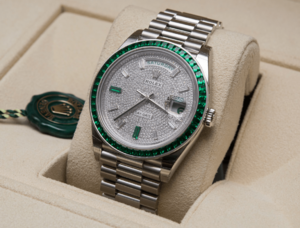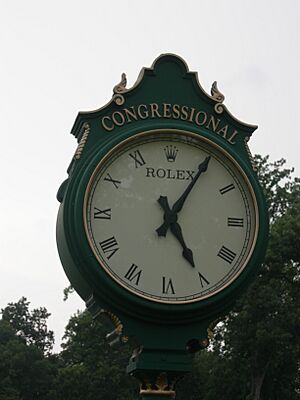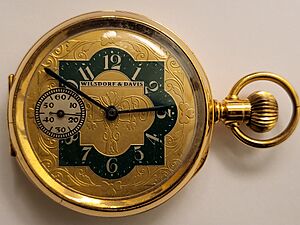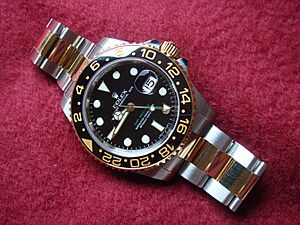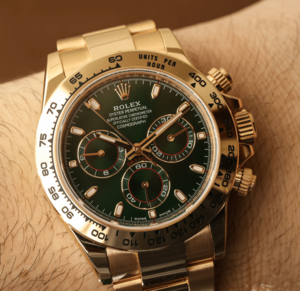Rolex facts for kids
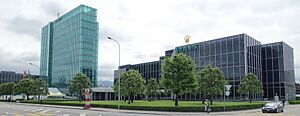
Headquarters in Geneva, Switzerland
|
|
|
Formerly
|
Wilsdorf and Davis (1905–1919) Rolex Watch Co. Ltd (1919–1919) Montres Rolex SA (1919–1920) |
|---|---|
| Société anonyme | |
| Industry | Watchmaking |
| Founded | 1905 in London |
| Founders |
|
| Headquarters |
,
Switzerland
|
|
Area served
|
Worldwide |
|
Key people
|
Jean-Frédéric Dufour (CEO) |
| Products | Watches |
|
Production output
|
|
| Revenue | |
| Owner | Hans Wilsdorf Foundation |
|
Number of employees
|
7000 |
| Subsidiaries | Montres Tudor SA Bucherer AG |
Rolex is a famous Swiss company that makes luxury watches. It is based in Geneva, Switzerland. The company started in 1905 in London by Hans Wilsdorf and Alfred Davis. It was first called Wilsdorf and Davis.
In 1908, they chose "Rolex" as the brand name for their watches. After World War I, the company moved to Geneva, Switzerland, in 1919. This was because of economic problems in England. Since 1960, the company has been owned by the Hans Wilsdorf Foundation, which is a private trust.
Rolex SA and its sister company, Montres Tudor SA, design and make wristwatches. These watches are sold under the Rolex and Tudor brands. In 2023, Rolex bought Bucherer, a company that sells watches.
Contents
History of Rolex
How Rolex Started
Alfred Davis and Hans Wilsdorf started their watch company, Wilsdorf and Davis, in London in 1905. They imported watch parts from Switzerland and put them into cases made in England. These early watches were sold to jewelers, who often put their own names on the watch faces.
In 1908, Wilsdorf registered the name "Rolex". He wanted a name that was easy to say in any language and short enough to fit on a watch. He also thought "Rolex" sounded like a watch winding up.
During World War I, Rolex made watches for soldiers. In 1919, Hans Wilsdorf moved the company to Geneva, Switzerland. This move happened because of high taxes on luxury goods in England after the war. The company's name changed to Montres Rolex SA and later to Rolex SA.
Important Inventions
In 1926, Rolex introduced the "Oyster" watch. This watch was special because it was waterproof and dustproof. Rolex showed off these watches by putting them in aquariums in store windows.
In 1927, a British swimmer named Mercedes Gleitze swam across the English Channel wearing an Oyster watch. This showed how waterproof the watch was. Rolex celebrated this by putting big ads in the Daily Mail newspaper.
In 1931, Rolex patented a new way for watches to wind themselves. It was called the "Perpetual rotor". This part used gravity to move freely and keep the watch wound. Because of this, the Oyster watch became known as the Oyster Perpetual. This invention changed how self-winding watches worked.
During World War II, Rolex supplied special diving watches to Italian underwater teams. Even though Switzerland was neutral, Hans Wilsdorf also sent watches to Allied prisoners of war. He often did not ask for payment until after the war. This helped Rolex gain a good reputation.
After his wife passed away in 1944, Wilsdorf created the Hans Wilsdorf Foundation. He left all his Rolex shares to this trust. This meant that some of the company's money would go to charity. Since Wilsdorf's death in 1960, this trust has owned and run Rolex SA.
How Rolex Works Today
In the early 2000s, Rolex started buying companies that made watch parts. This helped them make almost all parts of their watches themselves. This way, they could control the quality and production better.
In 2023, Rolex made about 1.24 million watches. They have a network of authorized dealers around the world. Sometimes, there are waiting lists for new watches. This helps keep the brand special and in high demand.
Rolex's Charitable Work
The Hans Wilsdorf Foundation owns Rolex SA. This foundation is a registered charity in Switzerland. It pays lower taxes because it gives money to good causes. Rolex keeps its financial details private. However, it is known that the foundation has supported social institutions in Geneva.
Other Watch Brands by Rolex
Tudor Watches
Rolex SA also makes watches under the Tudor brand. Montres Tudor SA has been designing and selling Tudor watches since 1946. Hans Wilsdorf created Tudor to offer watches that were reliable like a Rolex but cost less.
Tudor watches originally used movements from other companies. However, they used high-quality cases and bracelets like Rolex. Since 2015, Tudor has started making its own watch movements. Tudor watches are sold in many countries around the world.
How Rolex Watches are Made
Unique Serial Numbers
Every Rolex watch has a unique serial number. This number helps to tell when the watch was made. Serial numbers started in 1926. Since 2010, Rolex has used random serial numbers.
Quartz Watches
While Rolex is famous for its mechanical watches, it also helped develop quartz watch movements. In the late 1960s, Rolex worked with other Swiss watchmakers to create the Beta 21 quartz movement. Later, Rolex developed its own quartz movement for the Rolex Oysterquartz watch.
Materials Used
Rolex uses a special ceramic material called "Cerachrom" for its watch bezels. This material was first used in 2005. Cerachrom bezels do not fade from sunlight and are scratch-resistant.
Rolex also uses a special type of stainless steel called 904L. Most other Swiss watches use 316L steel. Rolex has used 904L steel since 1985. It is more resistant to corrosion and shines nicely when polished.
Famous Rolex Watch Models
Rolex has three main watch lines: Oyster Perpetual, Professional, and Cellini. The Cellini line includes dressier watches. The main bracelets for the Oyster line are called Jubilee, Oyster, President, and Pearlmaster. Rolex watches are made from materials like stainless steel, gold, or platinum.
Air-King Watches
Hans Wilsdorf created the Air-King line to honor RAF pilots from the Battle of Britain. The first model came out in 1958. The Air-King watches were known for being a more affordable Rolex option. In 2016, Rolex brought back the Air-King with a larger case and a special magnetic shield.
Oyster Perpetual Watches
The Rolex Oyster Perpetual watch is a direct descendant of the first waterproof Rolex Oyster watch from 1926. This line includes various models like the Oyster Perpetual 26, 31, 34, 36, 39, and 41. Some models, like the Oyster Perpetual Date 34, also show the date.
The Datejust models are similar to the Date models but offer more customization. They come in larger sizes and can have different metals, dial materials, and diamonds.
Professional Collections
Rolex has made special watches for extreme activities like deep-sea diving, mountain climbing, and aviation.
- The Rolex Submariner (1953) and Rolex Sea Dweller (1967) were made for divers. The Sea Dweller has a special valve to release helium gas during deep dives.
- The Explorer (1953) and Explorer II (1971) were designed for explorers. The Explorer was launched after the successful climb of Mount Everest in 1953. The Explorer II has a 24-hour hand, which is useful for telling day from night in places like caves or near the poles.
- The Rolex GMT Master (1955) was created for pilots. It could show two time zones at once, which was helpful for long flights.
Most Expensive Rolex Watches
Rolex watches can be very valuable.
- In 2017, a Rolex Daytona watch that belonged to actor Paul Newman sold for over US$17.75 million at an auction. This made it one of the most expensive wristwatches ever sold.
- Another Rolex Daytona, called the "Unicorn," sold for nearly US$6 million in 2018.
- The most expensive Rolex ever made by the factory was the GMT Ice, which had a retail price of US$485,350.
Rolex Sponsorships
Rolex supports many events and people.
- Since 1976, the Rolex Awards for Enterprise have given money to people working on important projects.
- The Rolex Mentor and Protégé Arts Initiative helps young artists learn from experienced mentors.
- Rolex has been the official timekeeper for the Le Mans 24 Hours car race since 2001. They were also the official timekeeper for Formula 1 racing from 2013 to 2024.
- Famous people like Jackie Stewart, Gary Player, and Roger Penske have advertised Rolex watches.
Rolex watches have also been part of amazing adventures.
- In 1960, a special Rolex watch was attached to the outside of the Trieste submarine. The submarine went to the deepest part of the ocean, the Challenger Deep. The watch worked perfectly even under extreme pressure.
- In 2012, when James Cameron made a similar deep-sea dive, a special Rolex watch was on his submarine's robotic arm.
Rolex Achievements
Rolex has made many important improvements in watchmaking:
- In 1926, they created the Oyster case, which was a very reliable waterproof watch case.
- In 1910, Rolex was the first to get a special certification for a small lady's wristwatch, showing it kept time very accurately.
- In 1931, they released a self-winding mechanism with a rotor that moved 360 degrees. This made it easier to keep watches wound and accurate.
- In 1945, they introduced the first watch that automatically changed the date on the dial.
- In 1953, they released a diving watch, the Rolex Oyster Perpetual Submariner, that was waterproof to 100 meters (330 feet).
- In 1954, they made a watch, the Rolex GMT Master, that could show two time zones at once.
- In 1956, Rolex made a watch that automatically showed both the day and the date.
Rolex in Culture
During World War II, Royal Air Force pilots bought Rolex watches. If they were captured, their watches were taken away. Hans Wilsdorf offered to replace these watches for free until the war ended. This helped boost the spirits of Allied prisoners. About 3,000 Rolex watches were ordered by British officers in one prison camp alone. This also helped Rolex become popular in America after the war.
A famous story involves Corporal Clive James Nutting, a prisoner of war. He ordered an expensive Rolex watch directly from Hans Wilsdorf. Wilsdorf sent the watch and said Nutting did not need to pay until after the war. This watch was believed to be used to time guard patrols during the famous "Great Escape" plan.
In a sad event, a Rolex watch helped solve a murder case. In 1996, a body was found in the English Channel. A Rolex watch was the only thing that could identify the person. Police used the watch's serial number and service records to find out who the person was and when they might have died.
Rolex watches are seen as a status symbol around the world. The company makes over 1 million watches each year.
See also
 In Spanish: Rolex para niños
In Spanish: Rolex para niños
- List of watch manufacturers


